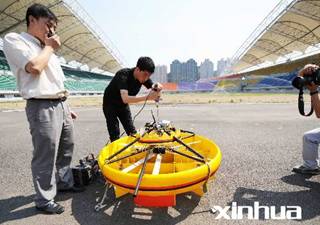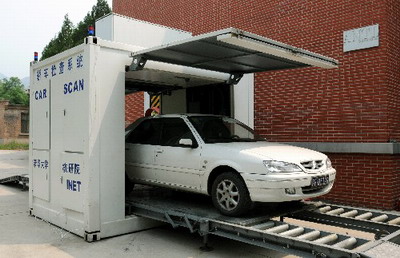|
CHINA SCIENCE AND TECHNOLOGY
NEWSLETTER
The Ministry of Science and Technology
People's Republic of China
|
|
|
N0.514 |
June 20,2008 |
|
|
|
|
|
|
|
|
IN THIS ISSUE
|
|
* Procurement Package between China and ITER
* Novel Approach to Detect Early Cancers
* One-Step Spinning Process
* Chinasat-9 Successfully Launched
* UFO-Like Flying Machine Launched
* Anti-terrorism See-through System
|
|
INTERNATIONAL COOPERATION |
Procurement Package between China and ITER
China inked on June 16, 2008 a package deal with ITER on procuring Toroidal Field Magnets, the first procurement accord reached between China and ITER since China becoming part of the program. According to ITER arrangements, China will mainly work on toroidal field magnets, poloidal field coils, high temperature plasma cover, and power system. The said tasks will raise China’s level of nuclear fusion study. While allowing China to step onto a higher level of nuclear fusion study, the efforts also create an opportunity for China working on commercial applications of nuclear fusion. The signing of the package deal marks China entering an important phase of implementing ITER missions, and indicates ITER moving into a critical phase of research and development. At the signing ceremony, representatives from the United States, Russia, Japan, India, the European Union, and ITER praised China’s efforts in the area.
Irradiation Produce New Corn Species
Breeding new corn species using ion beam irradiation, a project jointly undertaken by CAS Institute of Modern Physics and Gansu Jinxiang Seed, has recently achieved a major progress, thanks to more than two-year efforts. Researchers treated a wide range of corn seeds, including Jinxiang-4C, Zheng-58, Lu-9801, and CSR-24001, using 12C6 and 36Ar18, plus the ion beams in different dosages provided by the heavy ion accelerator at the Institute. They induced expected mutations in inbred corn lines through field growing, and created an advanced technical means for producing novel species.
Study results show that the treated seeds have a germination potential and rate that goes down along with an increased irradiation dosage. Researchers determined the right dosage of both 12C6 and ion beam irradiation, through measuring the response a species would have to such treatment. M1 corn species showed an apparently changed leave form, while M2 species saw changes in more aspects, including plant height, ear height, ear number per plant, color of male gametophytes, corn grain quality, row number per ear, grain weight, and resistance to diseases. Some mutations, including an increased plant height, a reduced ear height, increased number of ears at the same height, increased row number per ear and grain weight, changed grain quality from soft to hard, and an enhanced resistance to rust and red leave diseases, have secured a preferred mutation rate ranging between 7.0% and 17.9%. M3 species has registered a steady passing of preferred genetic mutations, with an enhanced photosynthesis, from which researchers have screened out 98 desirable mutated species. In 2007, researchers grew M4 species in experimental plots for further observation. An experimental growing of M5 species in Sanya, Hainan has resulted in 16 hybrid combinations with an increased yield by 17.1%-35.9%, a better resistance to diseases, and improved field performance, compared with the control group. In 2008, researchers have been working on DNA part of the mutations using molecular marker technology, in an attempt to understand the changed quality of 16 combinations that have recorded a yield increase.
More Applications for SpaceMutated Seeds
Heilongjiang Academy of Agricultural Sciences Institute of Horticulture has bred out improved species based on space mutated plants, and grown them on an expanded basis. In the period from 1987 to today, researchers have collected new seeds breeding materials to produce space mutated tomato species Yufan-1 and Yufan-2, and green peppers, including Yujiao-1, -2, -3, and -4.
Yujiao-1 sweet pepper is featured with an increased weight, enjoying an averaged weight at 200g, and the largest one at 400g. The mutated species claims an enhanced resistance to diseases and viruses, with reduced diseases indexes by 18.9% and 15.12%, compared with the dominating species. The pepper has a VC content of 132.26mg/l, or 29.9% more compared with the dominating species, enjoying a raised soluble solid content by 22.4%. The fragrant and high yield pepper is able produce a yield as high as 5,000 kg a mu (1 mu= 0.0667 hectare), or 16.42% higher than the dominating species. It can grow either in fields or in greenhouses.
Yujiao-2, the second space mutated generation, is a sweet species grown in space and sent back by a recoverable satellite in 1987, enjoying numerous merits, including large fruit, fine quality, enhanced resistance to diseases, even shape, smooth surface in a rectangular shape, and both sweet and crispy in taste. The mutated species grows vigorously in the field, enjoying a strong resistance to diseases and viruses. It has since 1993 grown on 210,000 mu of croplands in more than 20 provinces and cities, including Jilin, Liaoning, and Beijing, reaping an economic benefit worth RMB 420 million.
Yufan-1 tomato savors a vigorous growth, with a height reaching 2m or more in a greenhouse environment. After a growth period ranging between 110 and 115 days, the mutated species would produce a large sweet fruit of high nutrition content, with the largest one weighing 0.8kg and the averaged one 0.25 kg. The fruit, bright yellow in color with thick sandy and sweet flesh, may produce a yield of 5,000 kg a mu. The new species has gown in some 200,000 mu, produced an added value worth RMB 200 million.
Novel Approach to Detect Early Cancers
A study led by WANG Erkang, a research fellow at CAS Changchun Institute of Applied Chemistry, and KONG Jilie, a professor at Fudan University, has since January 2004 worked on real-time analysis of markers, in an attempt to diagnose cancers at an early stage. In the past 4 years, researchers have realized real-time, sensitive, and specific tests of selected cancer markers, using a range of advanced techniques, including CE-ECL, SPR, LIF, spectrum techniques, protein chips, and genetic chips.
Based on the said accomplishments, they developed an improved CE-ECL process to detect prolidase, a marker for both liver and breast cancers. They also rolled out a highly sensitive and selective analysis system integrating an array of advanced technologies, and chips able to test diverse proteins and genes. These new approaches have been applied in clinical diagnosis, and in establishing a clinical database for the purpose. Researchers studied the pharmacokinetics of prolidase activity in red blood cells, to unveil the effects of drugs on cancers through understanding the effects of drugs on enzyme activity. They established a process to test aspartate aminotransferase (AST) and alanine aminotransferase (ALT), and study the harmful effects of alcohol on liver cancer cells. In addition, they examined the interactions between an anti-cancer drug called Mitoxantrone and Calf Thymus DNA and cytochrome c, in an attempt to provide theoretical evidences for targeted drug combinations.
One-Step Spinning Process
In collaboration with Changjiang Chemical Fibers, CAS Chagnchun Institute of Applied Chemistry has developed a one-step spinning process to produce poly-lactic-acid fibers. Researchers have landed breakthroughs in developing the key technologies for producing poly-lactic-acid fibers since 2006. They successfully produced poly-lactic-acid fibers from a model unit in November 2006. Based on the development, they rolled out a proprietary continuous spinning process working mainly on the film reactor, with an annual capacity of 50 tons, after addressing numerous technical difficulties, including material feeding, mixing, temperature control, and transition from constant pressure, to vacuum, and further to high pressure. On November 2007, they successfully rolled out poly-lactic-acid fibers at a speed of 2800~5000m per minute.
Chinasat-9 Successfully Launched

At 2015, June 9, 2008, China successfully blasted off Chinasat-9, a direct broadcasting satellite, aboard a CZIIIB launch vehicle, from the Xi’chang Satellite Launch Center. 26 minutes after lifting off, the Xi’an ground control center received the data showing that the satellite was separated from the carrier rocket. The satellite entered a geosynchronous orbit with a perigee altitude of 214 km, an apogee altitude of 49,887 km, and an orbit inclination angle of 24.2 degrees. Equipped with 22 ku transponders and a power output of 10,700w, the new satellite is designed to work in orbit for 15 years.
UFO-Like Flying Machine Launched

Preparation for flying.

Flying like a UFO.

Flying High.
Not long ago, Ha’erbin Shengshi Special Flying Machine, China-Aerospace Science and Industry Corporation No. 4 Institute, and Harbin Engineering University, have jointly made the debut of a UFO like flying machine. With a diameter of 1.2m, and a weight of 10 kg, the flying machine is designed with a special dynamic system in a UFO shape, able to fly to a height of 50~1000m at a speed of 0~80km per hour. The flying machine flies 40 minutes with a full fuel load, enjoying the merits of both helicopter and aircraft, including lower altitude flying, flying at a reduced speed, vertical taking off and landing, and suspension flying.
Unrestricted by terrains and with a pre-set flying route, the flying machine can be used to provide technical support for numerous missions, including aerial photographing, geological mapping, high pressure power line inspection, oil pipeline inspection, high way management, forest fire inspection, toxicant gas inspection, drug traffic control, emergency telecommunication platform, and rescue.
Anti-terrorism See-through System

An anti-terrorism scan system for sedan cars, developed by Tsinghua University, has recently passed an approval check. The nuclear and new energy research center, part of the university, installed a Co-60 source unit in an alloy shelter, allowing an automatic loading and unloading in a delivery truck. It can be delivered to a destination to perform a vertical see-through inspection on sedan cars. The system is able to transmit its high definition images in a wireless manner. It takes only 30 seconds to ‘see through’ a car. It will soon be employed to perform security missions at the Customs, important institutions, public meeting places, and large theaters.
Liver Transplant Patients Live Longer
Statistics published by CLTR show that 80.6%of Chinese liver transplant patients have survived at least one-year after operation, doubled the percentage of 40 achieved in the 1990s, and approached a level of developed countries.
CLTR, a Chinese database on liver transplant, has collected the information on some 12,000 liver transplant patients since 2005. 61 domestic hospitals and centers qualified for liver transplant have become part of the system. CLTR, a system designed to track down liver transplant patients on a long term basis, has changed unsystematic, ineffective, and passive mode of tracking down liver transplant patients. A doctor is now able to contact or visit liver transplant patients when necessary, and to hospitalize patients whenever they show a major symptom, such as fever, liver pain, jaundice, and increased hepatic related enzymes. Up to date, China has performed some 85,000 organ transplants, only next to the United States in number. In recent years, China performed organ transplants on more than 10,000 patients a year, with kidney transplant topping others, and a longest survival span for 28 years. Liver transplant has exceeded 10,000in number, with the longest survival span for 12 years. Heart transplant went over 100 in number, with the longest survival record approaching 14 years.
China’s Proprietary Plasma-Screen TV
The first batch of 42” color plasma-screen TV manufactured with China’s own proprietary technologies has recently been rolled off a production line in Nanjing. Researchers achieved major breakthroughs in addressing the key technologies for making the set work, including module design, pilot production, whole set design, tribasic florescent powder spraying, surfacing processing, and metal and glass base board sealing. Derived from the project are 97 patent applications, of which 57 are invention patents. So far the project has been granted with 27 patents, which makes the color plasma-screen TV the result of China’s own technology. The development of the proprietary TV set has spurred up the development of domestic PDP and equipment manufacturing industries, allowing a noticeably raised capacity and reduced cost for producing PDP.
China First RTP Production Line
It takes 3 years for Guangzhou Lijin New Technology to work out the proprietary technologies and equipment to manufacture Reinforced Thermoplastic Pipe (RTP). The one-step manufacturing process, the first of its kind in the world, is able to produce 3-6inch RTPs in a continuous manner, eliminating the unnecessary part of the two-step process. Employing advanced multi-structured chemical fibers to enhance the pipe, the technology raises the pipe’s maximum work pressure to 15MPa. The Chinese company has developed its own intellectual property in RTP structure design, pipe making equipment, four-tiered binding technique, and control software.
Comments or inquiries on editorial matters or Newsletter content should be directed to:
Mr. XU Chaoqian, Department of International Cooperation, MOST 15B, Fuxing Road, Beijing 100862, PR China Tel: (8610)58881360 Fax: (8610) 58881364
http://www.most.gov.cn |

